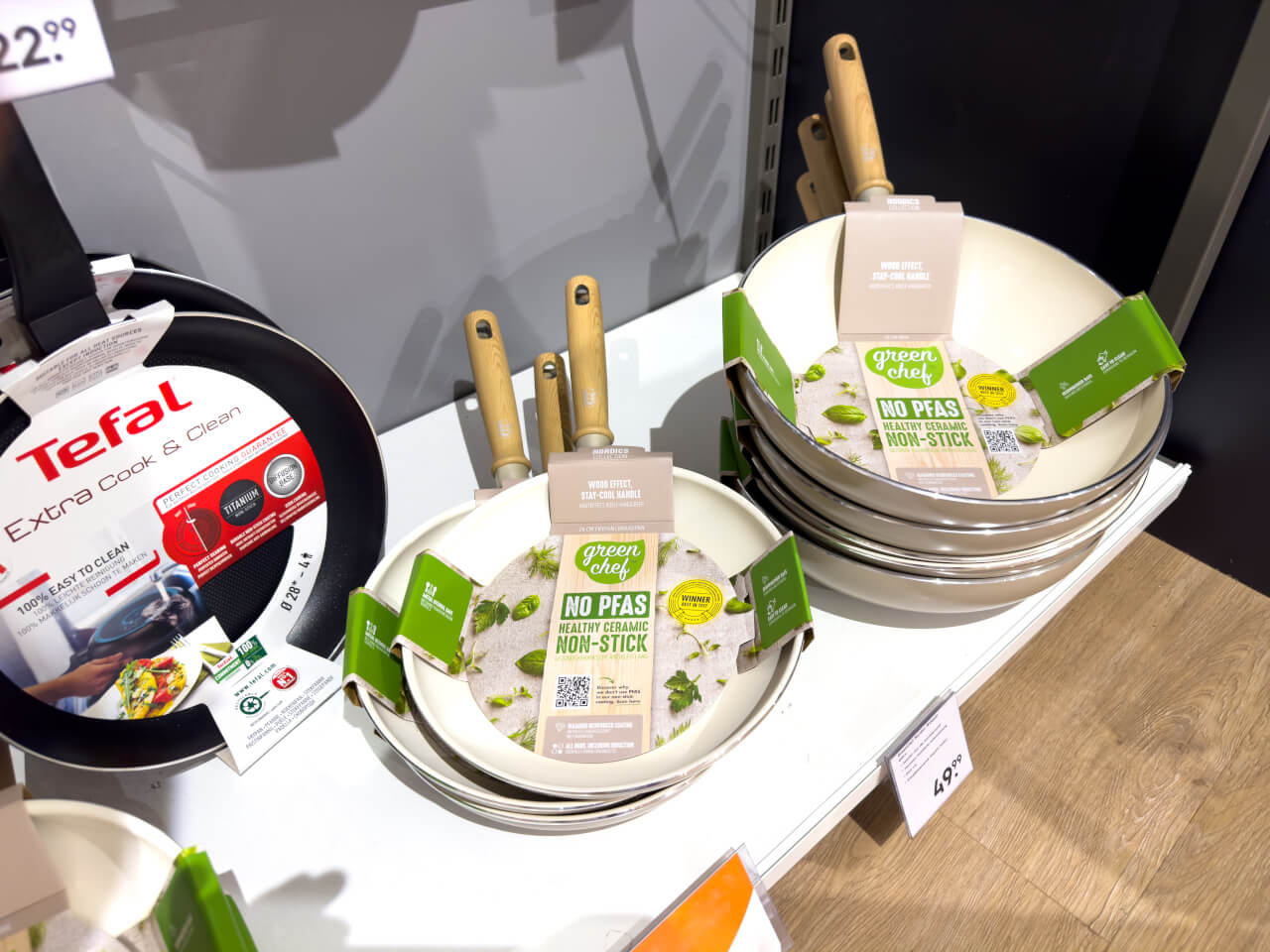PFAS: Behind the Label
How do you know if your products are PFAS-free or not? Here’s our expert-informed guide.
This story is part of our ongoing PFAS series, The PFAS Problem: Demystifying ‘Forever Chemicals’
In previous coverage, we’ve told you about PFAS—per- and polyfluoroalkyl substances that don’t readily break down and can accumulate in humans, causing serious health problems.
We’ve also told you about how the EPA recently passed its first-ever regulations on a handful of PFAS in drinking water, and how these rules leave a lot to be desired.
And then we told you about some of the ways you can reduce your own personal exposure to these chemicals while you wait for the slow wheels of government to turn. And if you read that article, you know that making shrewd decisions while you shop can help reduce the amount of PFAS with which you come into contact.
“I think the best thing that people can do is be educated consumers,” says Kyla Bennett, science policy director for Public Employees for Environmental Responsibility (PEER).
Many items in the retail sphere won’t have information about PFAS use because it’s not required. To make matters more complicated, a PFAS-free label doesn’t necessarily give you all the information you need. Potential PFAS-free greenwashing may or may not be intentional, but regardless, that label might need closer inspection. We consulted some experts to help you understand how to find PFAS-free items in the marketplace.
Start with a trustworthy list
Verifying if something is PFAS-free can be tough, so don’t reinvent the wheel if you don’t have to. Here is a trustworthy list of brands and products that you can buy knowing they are PFAS-free, as well as a comprehensive buying guide.
This list from PFAS Central is a good source for outdoor gear, apparel, kitchenware and more. Food & Water Watch recently released a thorough buying guide to help you side-step PFAS in everything from paint to menstrual products to furniture.
Know the laws where you live
More than a dozen states have passed some kind of legislation restricting the use of PFAS in consumer products such as foods, packaging, apparel and carpeting. We do not yet have the ability to test for all of the thousands of PFAS, so one way to screen for PFAS is by testing for the total amount of fluorine in a product. This test can serve as a good indicator of whether there is PFAS in a product, although it’s not yet clear exactly what level of PFAS is present from directly adding PFAS versus unintentional PFAS contamination.
“It’s an imperfect method, but it’s one of the better methods that are out there, especially when you couple it with more in-depth testing,” says Mike Schade, director of the Mind the Store Program for Toxic-Free Future.
Washington State has been a leader on this front, and Schade points to the state’s Safer Products for Washington Act, which gives the state regulatory authority to ban chemicals that are hazardous.
“Raise your voice for policy change,” says Schade. “We know that the federal government is slow at making change around chemicals like PFAS. There’s been a lot more progress at the state level.”
You can use this bill tracker from Safer States to find out what states have either introduced or enacted legislation to ban PFAS in different product categories.
Ask the right questions
When you have the time and opportunity to ask a company about its products, asking the right questions is key. Inquiring whether something is PFAS-free might not cut it.
Here are three key questions you can ask:
Does this product use nonstick or waterproof properties?
PFAS specifically are used for their waterproof and nonstick qualities, so those are good flags.
“Every time I’m going to buy something, like if I’m buying a kitchen appliance, I call and I say is there nonstick on there? Because if it is, I’m not going to buy it,” says Bennett.

Does this product use fluorinated chemistry?
This is a good catch-all question, because while we do not yet have the ability to test for all PFAS, if there is fluorinated chemistry in a product, this is a reliable indicator that there will be PFAS in the product.
Sometimes, companies will call out a certain PFAS by name. The specificity is helpful, but at the same time, it’s important to understand what this means. Just because the product doesn’t contain one specific PFAS doesn’t mean that it doesn’t contain another that is just as dangerous.
“[Companies] say oh, we have no PFOA,” says Bennett. “That means they have no PFOA, but they could have 11,999 other PFAS in them. So, they really have to ask the right questions like ‘Is there any fluorinated chemistry at all in your product?’ And that kind of covers the whole thing.”
What alternatives to PFAS do you use?
“PFAS-free is good, but it’s not enough,” says Schade. “And if I’m a consumer, what I would do is I would ask companies ‘How are you ensuring the alternative that you’re now using is safer? What are you doing to evaluate the safety of alternatives?’ Getting into the nuances of 100 parts per million versus 50 parts per million, I think that’s too challenging of an area for most consumers to navigate, quite honestly. But I think asking questions about how are you vetting the safety of alternatives, I think that is a more productive and useful question to ask, because most companies are not thinking about it.”
Beware suspect alternatives
In manufacturing, it’s possible to substitute one well-known PFAS for an alternative that is simply another, less common PFAS. Known as “regrettable substitutions,” these swaps can be just as harmful to your health.
But you also want to be sure that PFAS aren’t being changed out for another type of chemical that is just as bad. Schade recommends looking for certifications or policies that are specific about what types of alternatives are allowed.
“Most laws that are out there and most company policies that restrict PFAS don’t do a good enough job ensuring that companies are utilizing truly safer alternatives,” says Schade.
Schade points to GreenScreen Certified as an example of a third-party standard that not only restricts PFAS but also restricts other chemicals of concern—not all third-party standards will cast this wide of a net.
Want more choices? Schade also recommends EPA Safer Choice and Cradle to Cradle.
Start conversations with retailers
Businesses and retailers can be huge forces for change, says Schade. “Another thing that consumers can do is reach out to the retailer’s businesses that you support, that you shop at and ask them whether or not they’re taking action on PFAS.”
Campaigning has compelled major retailers including Whole Foods, REI and Dick’s Sporting Goods to take some action on PFAS. According to Schade, it really does have the potential to start a conversation within the company.
Visit Retailerreportcard.com to learn which companies are leading and which are lagging when it comes to addressing PFAS. You can even use this site to contact the companies at the back of the pack and ask them to prioritize safer chemicals.
Kyla Bennett is the science policy director at PEER, and she wants to answer your questions about PFAS. Submit your question to [email protected]
Follow us
This work is licensed under a Creative Commons Attribution-NoDerivatives 4.0 International License.
Want to republish a Modern Farmer story?
We are happy for Modern Farmer stories to be shared, and encourage you to republish our articles for your audience. When doing so, we ask that you follow these guidelines:
Please credit us and our writers
For the author byline, please use “Author Name, Modern Farmer.” At the top of our stories, if on the web, please include this text and link: “This story was originally published by Modern Farmer.”
Please make sure to include a link back to either our home page or the article URL.
At the bottom of the story, please include the following text:
“Modern Farmer is a nonprofit initiative dedicated to raising awareness and catalyzing action at the intersection of food, agriculture, and society. Read more at <link>Modern Farmer</link>.”
Use our widget
We’d like to be able to track our stories, so we ask that if you republish our content, you do so using our widget (located on the left hand side of the article). The HTML code has a built-in tracker that tells us the data and domain where the story was published, as well as view counts.
Check the image requirements
It’s your responsibility to confirm you're licensed to republish images in our articles. Some images, such as those from commercial providers, don't allow their images to be republished without permission or payment. Copyright terms are generally listed in the image caption and attribution. You are welcome to omit our images or substitute with your own. Charts and interactive graphics follow the same rules.
Don’t change too much. Or, ask us first.
Articles must be republished in their entirety. It’s okay to change references to time (“today” to “yesterday”) or location (“Iowa City, IA” to “here”). But please keep everything else the same.
If you feel strongly that a more material edit needs to be made, get in touch with us at [email protected]. We’re happy to discuss it with the original author, but we must have prior approval for changes before publication.
Special cases
Extracts. You may run the first few lines or paragraphs of the article and then say: “Read the full article at Modern Farmer” with a link back to the original article.
Quotes. You may quote authors provided you include a link back to the article URL.
Translations. These require writer approval. To inquire about translation of a Modern Farmer article, contact us at [email protected]
Signed consent / copyright release forms. These are not required, provided you are following these guidelines.
Print. Articles can be republished in print under these same rules, with the exception that you do not need to include the links.
Tag us
When sharing the story on social media, please tag us using the following: - Twitter (@ModFarm) - Facebook (@ModernFarmerMedia) - Instagram (@modfarm)
Use our content respectfully
Modern Farmer is a nonprofit and as such we share our content for free and in good faith in order to reach new audiences. Respectfully,
No selling ads against our stories. It’s okay to put our stories on pages with ads.
Don’t republish our material wholesale, or automatically; you need to select stories to be republished individually.
You have no rights to sell, license, syndicate, or otherwise represent yourself as the authorized owner of our material to any third parties. This means that you cannot actively publish or submit our work for syndication to third party platforms or apps like Apple News or Google News. We understand that publishers cannot fully control when certain third parties automatically summarize or crawl content from publishers’ own sites.
Keep in touch
We want to hear from you if you love Modern Farmer content, have a collaboration idea, or anything else to share. As a nonprofit outlet, we work in service of our community and are always open to comments, feedback, and ideas. Contact us at [email protected].by Lena Beck, Modern Farmer
May 29, 2024
Modern Farmer Weekly
Solutions Hub
Innovations, ideas and inspiration. Actionable solutions for a resilient food system.
ExploreShare With Us
We want to hear from Modern Farmer readers who have thoughtful commentary, actionable solutions, or helpful ideas to share.
SubmitNecessary cookies are absolutely essential for the website to function properly. This category only includes cookies that ensures basic functionalities and security features of the website. These cookies do not store any personal information.
Any cookies that may not be particularly necessary for the website to function and are used specifically to collect user personal data via analytics, ads, other embedded contents are termed as non-necessary cookies.
